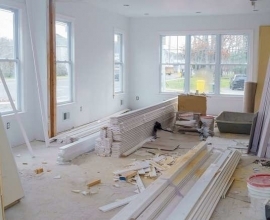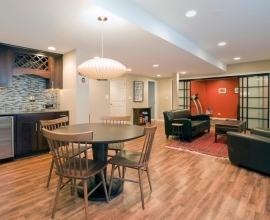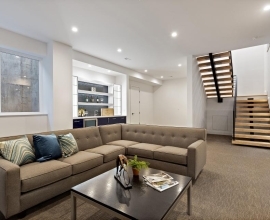How to Manage the Cost to Finish a Basement
A finished basement increases your home’s usable space, but taking it from concrete and cobwebs to a comfy hangout spot may be pricier than you think.
The cost to finish a basement and turn it into a livable space ranges from $6,500 to $18,500 on average, according to analysis by Home Advisor. Basement remodeling projects — to improve or replace existing features — tend to cost between $10,000 and $30,000.
Your basement finishing costs could fall anywhere on the spectrum, depending on room size, where you live and how extensive the improvements are.
Find out what factors affect the cost to improve a basement and how to keep expenses under control.
Breaking down the cost to finish a basement
Finishing, remodeling or renovating: While contractors might see subtle differences, all three terms describe a basement improvement project.
No matter what you call it, finishing typically involves adding walls, a floor, electricity and lighting so the basement is ready for habitation, says Bryan Sebring, a certified graduate remodeler and owner of Sebring Design Build in Naperville, Illinois.
Flooring and wall coverings like paneling are the biggest expenses, making up approximately 15% of the total cost to finish a 1,200 square-foot basement, Sebring says. Plumbing and electricity are next, at around 14% and 11% of the cost, respectively, while interior carpentry needs — like trim and railings — account for about 10%. Remaining costs may include things like drywall and insulation, cabinets and countertops, painting and even cleanup.
Exact costs will vary depending on basement size, whether extra features like a bathroom or wet bar are included, and how fast you want the job completed, Sebring says. And that’s assuming your unfinished basement is in good condition.
It’s important to have your basement inspected for foundation and drainage issues before finishing. If an inspection reveals water damage or the risk of water seepage, basement waterproofing and possibly foundation repair will likely add to the cost.
How to plan your basement finishing project
CONSIDER NEEDS AND NEIGHBORHOOD
Do you want a place for the kids to hang out after school, or are you dreaming of a state-of-the-art man cave? The way you’ll use the space will dictate how extensive the improvements need to be.
Look at other houses in the neighborhood as well, says Nick Yahoodain, president of Advanced Builders & Contractors in Los Angeles. If unfinished basements are common in your market, improving other areas of the house might be a smarter investment.
SET A BUDGET
Make a list of the features you absolutely need, then add a few things you’d like. Once you’ve decided what you’re willing to spend, talk to a contractor. That discussion should help you separate realistic improvements from the upgrades that will bust your budget.
It’s not uncommon to spend 15% to 20% of the home’s value on a basement improvement project, Sebring says. He cautions against spending more unless you’re sure you’ll live in the house for more than five years.
THINK ABOUT ROI
Yahoodain considers the effect on value to be the “golden rule” when it comes to home improvements. Will a finished basement help you rent or sell your home in the future? If the answer is no, your money might be better spent in another part of the house, he says.
Though basements — even finished ones — don’t usually add square footage to your home for appraisal purposes, they can have a positive impact on marketability. A basement finished to include a bathroom, bar area and living space recoups around 70% of its cost in improved resale value, according to Remodeling magazine’s 2017 Cost vs. Value Report.
HIRE THE RIGHT PRO
In many cases, basement finishing is best left to professionals, but choosing a contractor requires some research. Take the time to:
Request estimates from more than one contractor to avoid overspending
Read verified reviews of each pro and the materials they suggest
Ask for past customer referrals and find out if their projects were finished on time and within the original budget
Check with your local building department or state consumer protection agency to be sure potential contractors are properly bonded, licensed and insured
Make your finished basement more affordable
1. KEEP IT SIMPLE
Opt for standard materials and fixtures instead of custom features to avoid premium prices. And resist the urge to add features that require expensive plumbing or electrical work like a wet bar or home theater system.
2. OPT FOR OPEN SPACE
Unless you have a genuine need for an enclosed workshop, office or exercise room, leave the space open. Carving your basement into separate rooms means paying for additional studs, electrical wiring, drywall and doors, and limits the ways you can use the space.
3. CHOOSE CARPET
Hardwood, laminate and tile flooring significantly increase the cost to finish a basement. Sebring, who calls carpet “the king of basement flooring,” says many people are scared about the consequences if a carpeted basement floods. But even top-of-the-line vinyl and tile has to be pulled up if there’s serious water damage, he says, and you can replace carpet multiple times for the same cost of installing hard flooring once.
4. DIY (WITH CAUTION)
All but the most skilled and motivated homeowners should leave basement finishing to the experts. “You run the risk of not understanding the building codes and having to tear it out and redo it,” Sebring says. Hiring subcontractors and managing the job on your own, rather than hiring a general contractor, could save some cash, but be prepared to treat it like a full-time job, he says.
Source: https://bit.ly/2J2tvip







